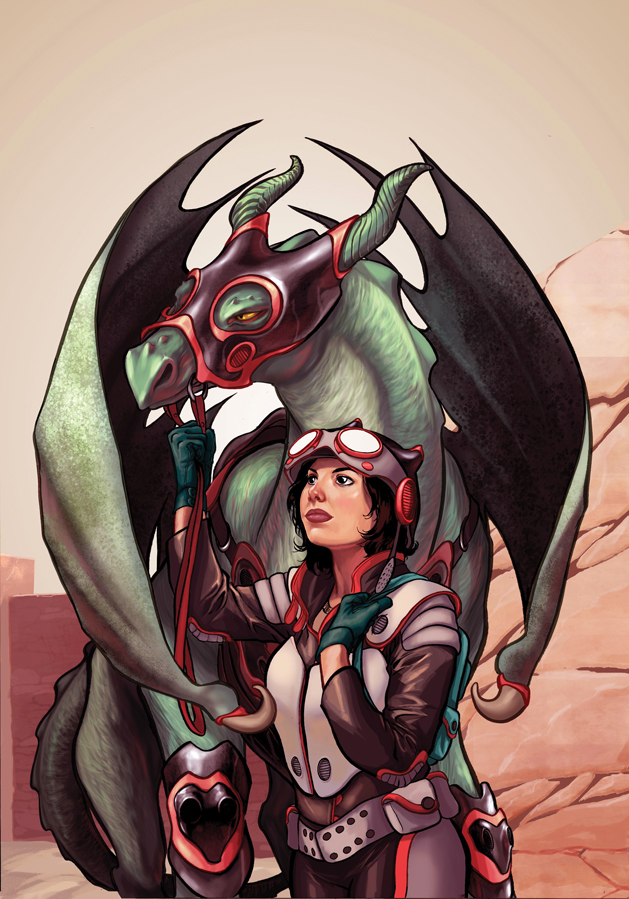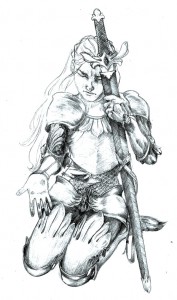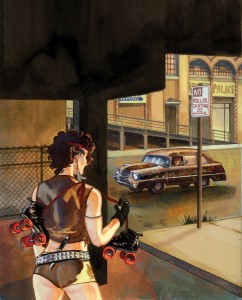 Self-described as a “roller derby girl, budding accordionist, lover of all comics,” Alison Blackwell brings to the artistic table a wealth of eccentricities
Self-described as a “roller derby girl, budding accordionist, lover of all comics,” Alison Blackwell brings to the artistic table a wealth of eccentricities
– none more impressive than her illustrations of people both real and fictional – and her work can be found in magazines and galleries across the state.
Dale J Rappaneau, Jr: With you being a badass roller derby girl, would you say the time spent in roller skates influences your illustration style?
Alison Blackwell: Being involved in sports, and derby especially, has led to a life of discipline. Before playing derby, I expected everything I  drew to be amazing, and then I’d get upset at myself when it wasn’t. Having the experience of tripping up several times before nailing a new skating skill, or getting beat to hell five jams to every one successful jam has allowed me to understand that any pursuit, even one that comes easily, is going to be mostly about trial and error.
drew to be amazing, and then I’d get upset at myself when it wasn’t. Having the experience of tripping up several times before nailing a new skating skill, or getting beat to hell five jams to every one successful jam has allowed me to understand that any pursuit, even one that comes easily, is going to be mostly about trial and error.
DJR: How does your mind work when envisioning a piece and then actualizing it?
AB: Most of the time that I’m making art, it’s for a client, and often the turnaround is very quick. I’ve learned to become very decisive, but I have to say that the sketch phase, where I’m trying to work out the composition and value hierarchy, is the hardest. Seldom is it a transportive or intuitive experience. It’s more like trying to solve a tough math problem.
DJR: What does illustration mean as an art?
AB: Illustration is about message. Illustrators are always trying to communicate an idea or story and strike a tenuous balance between artistic expression and clarity. How can I get my point across without being obvious or clunky? How can I make the image visually interesting but still readable? For the illustration to be successful, it’s imperative that the audience “gets it.”
DJR: When someone hears the word “art,” they typically imagine the fine arts, not illustrations. Do you have a theory for why illustration remains a less popular (and less understood) art form?
AB: Art that has a commercial aspect to it, like illustration, animation, video game design, comics and even graphic design, is from a separate world than the fine arts. A lot of the skill sets required are fundamentally the same, but the means by which the audience is reached is different. However, I don’t feel as if that has to cheapen the artist’s vision. Jeff Smith’s epic graphic novel series, Bone, is about sentient bone creatures and dragons and rat beasts. Kids go nuts for it, but you never get the sense that Smith watered down his ideas to make them more marketable. The best an illustrator can hope for is to use his or her own authentic voice while creating art, and find a market that appreciates that voice.
world than the fine arts. A lot of the skill sets required are fundamentally the same, but the means by which the audience is reached is different. However, I don’t feel as if that has to cheapen the artist’s vision. Jeff Smith’s epic graphic novel series, Bone, is about sentient bone creatures and dragons and rat beasts. Kids go nuts for it, but you never get the sense that Smith watered down his ideas to make them more marketable. The best an illustrator can hope for is to use his or her own authentic voice while creating art, and find a market that appreciates that voice.
DJR: Lastly, what is your best piece of advice for today’s generation of up-and-coming illustrators?
AB: Find what it is that you love to do, and be the best at that. When you really love the work you’re doing, even if it’s dorky or lowbrow, your work will be more genuine. And getting a positive response, however small, for work you poured your heart into is far more rewarding than pandering.
For more information, find Alison Blackwell at thisaremydrawingblargh.blogspot.com.


